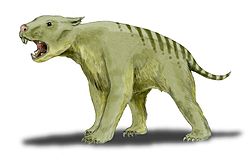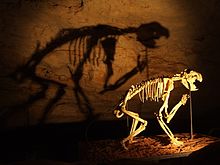
Kingdom: Animalia
Phylum: Chordata
Class: Mammalia
Order: Diprotodontia
Family: Thylacoleonidae
Genus: Thylacoleo
Species: T. carnifex
Temporal Range: Early - Late Pleistocene
The marsupial lion is an extinct species of carnivorous marsupial mammal that lived in Australia.This is the last and largest member of the Thylacoleondae. Despite its name, it is not closely related to the lion, but is a member of the order Diprotodontia.

Description
The marsupial lion is the largest meat-eating mammal known to have ever existed in Australia and one of the largest marsupial carnivores from anywhere in the world. Individuals are about 75 cm high at the shoulder and about 150 cm from head to tail. Its up to 160 kg in weight.
The animal was extremely robust with powerfully built jaws and very strong fore limbs. It possessed retractable claws, a unique trait among marsupials. This would have allowed the claws to remain sharp by protecting them from being worn down on hard surfaces.The claws were well-suited to securing prey and for climbing trees. The thumbs of each hand were semi-opposable and bore an enlarged claw. This would have been used to grapple its intended prey as well as providing it with a sure footing on tree trunks and branches. The marsupial lion had a relative thick and strong tail. Like the kangaroos, these marsupial lions also used its tail to support itself when on its hind legs. Taking this stance would free up its fore limbs to takle or slash at its intended victim.
The jaw muscle of the marsupial lion jaws exceptionally large for its size, giving it an extremely powerful bite. Biometric calculations shows considering size, it had the strongest bite of any known mammal, living or extinct. a 101 kg individual would have had a bite comparable to that of a 250 kg African lion. The skull was so specialized for big games.It was very inefficient at catching smaller animals.

Habitat
Thylacoleo was widely distributed across Australia during the Pleistocene. It has been found in all Australian states. Most of the sites where Thylacoleo fossils have been found are interpreted as dry, open forest habitat.
Evolution
The evolution of these marsupial lions were very interesting. It is believed that the ancestors of the marsupial lions had been herbivores, which is unusual for carnivores but it is confirmed that this Thylacoleonids share a common ancestor with wombats. While other continents were sharing many of their predators amongst themselves, as they were connected by land. Australia's isolation caused many of its normality docile herbivorous species to turn carnivorous. Possum-like features were once thought to indicate that the marsupial lion's evolutionary path was from a phalangeriform ancestor, however, scientists agree that more prominent features suggest a vombatiform ancestry.
Behavior
The marsupial lion was a powerful animal but it was not a particularly fast runner. Most probably the marsupial lions were solitary. Their are not much Social behavior is known about these marsupial lions.
Diet
The diet of the marsupial lions has been the subject of much debate. Thylacoleo has been described as a carnivore, a bone crusher, a scavenger or perhaps even an herbivore. It was first described as One of the fellest and most destructive of predatory beasts.
Recently from CT Scan of their skull we came to know, they had a very good senses of hearing, sight and smell. From this we expect, they are active predators.
Again their unusual teeth and herbivorous ancestry suggested, they are herbivores.
And from the hind leg structure it is confirmed that they are not fast runner, but their body is heavily built which means they can frighten other comparatively small predators and they did that and scavenge food from them.
Now to exist and dominate the landscape every animal uses their all strength. Then why not these marsupial lions. What may be happened was like this -- They are active predators, a deadly scavenger and a herbivore too if needed.
crocodile eggs, carrion, meat and bone marrows were their suggested diet for them. They also take megafauna's as their meal.
The are not suited to catching smaller prey, they are ambush hunter. It would have coexisted with many of the so-called Australian megafauna such as the previously mentioned Diprotodon, giant kangaroos are Megalania as well as giant wallabies like Protemnodon, the giant wombat Phascolonus and the thunderbird Genyornis. All of these Pleistocene megafauna would have been the prey for the marsupial lion who was especially adapted for hunting large animals.
Extinction
As for most of the Australian megafauna, the events leading to the extinction of T. carnifex remain unclear. The hypothesized causes are the impacts of long-term climate change (both in the higher frequency extreme weather events and more subtle shift in temperature regimes, rainfall patterns etc.), hunting pressure and habitat changes imposed by humans.
When modern humans first arrived in Australia likely more than 60,000 years ago. it is thought that they had substantial impacts on the ecosystem by efficiently hunting large animals and by altering vegetation patterns through fire-stick farming. This has frequently been implicated in the disappearance of the majority of large Australian animals during the Pleistocene. On the other hand, many Australian fossil sites have yielded records of megafauna disappearance well before human presence in the area, giving weight to the interpretation that other factors most likely climate-related were the prominent drivers. The question remains the subject of ongoing research.

When modern humans first arrived in Australia likely more than 60,000 years ago. it is thought that they had substantial impacts on the ecosystem by efficiently hunting large animals and by altering vegetation patterns through fire-stick farming. This has frequently been implicated in the disappearance of the majority of large Australian animals during the Pleistocene. On the other hand, many Australian fossil sites have yielded records of megafauna disappearance well before human presence in the area, giving weight to the interpretation that other factors most likely climate-related were the prominent drivers. The question remains the subject of ongoing research.

No comments:
Post a Comment